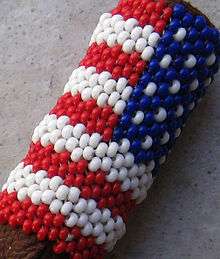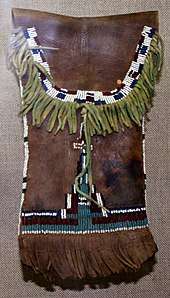Peyote stitch
The peyote stitch, also known as the gourd stitch, is an off-loom bead weaving technique. Peyote stitch may be worked with either an even or an odd number of beads per row. Both even and odd count peyote pieces can be woven as flat strips, in a flat round shape, or as a tube. Tubular peyote is used to make pouches or to decorate objects such as bottles or fan handles.

Many cultures around the world have used peyote stitch in their beadwork. Examples of peyote stitch have been found in artifacts from Ancient Egypt, and the stitch has also been used in historic and contemporary Native American beadwork. The name "peyote stitch" derives from the use of this stitch to decorate objects used in peyote ceremonies by members of the Native American Church.[1] The name "gourd stitch" similarly derives from the use of the stitch in decorating gourd containers.
Variations on Peyote stitch
A variation of the peyote stitch is often referred to as the fast peyote stitch as its use resembles peyote, but it can be done in less time.
Much like the first two rows of a peyote stitch project, the speed stitch requires two rows be strung then worked in. It can only be done with an even number of beads but is easily done in either flat or tubular peyote.
Peyote Stitch can be done in the round, on the diagonal, flat or tubular. A versatile stitch which is a favourite of many beaders.
A new form of peyote stitch has been created by Gerlinde Linz. This is called Peyote with a twist, not bead crochet. Often abbreviated to PWAT, although Linz prefers Peytwist. This form of diagonal peyote, when worked up into a chain can form the look of a crochet rope.
The Cellini spiral was originated by seed bead masters Virginia Blakelock and Carol Perenoud who developed the tubular variation and named it after Benvenuto Cellini, a 16th-century Italian sculptor known for his Rococo architectural columns. Eventually, the flat version emerged, and both techniques are equally beautiful.
See also
References
- Hackbarth, Emily. "Peyote Stitch Beading Class Part One". About.com: Beadwork. Retrieved 2008-06-02.
External links
- BeadJewelryMaking: Peyote Stitch Instruction: even count flat, odd count flat and Tubular peyote stitch
- Bead Wrangler - Preserving Beadwork History for the new Millennium: Peyote Samples No longer a functioning site.
- Fire Mountain Gems video tutorial
- Beadage Glossary: Peyote Stitch
